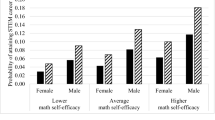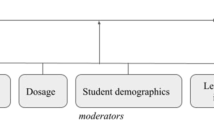Abstract
Declining enrolments in science, technology, engineering and mathematics (STEM) disciplines and a lack of interest in STEM careers are concerning at a time when society is becoming more reliant on complex technologies. We examine student aspirations for STEM careers by drawing on surveys conducted annually from 2012 to 2015. School students in years 3 to 12 (n = 6492) were asked to indicate their occupational choices. A logistic regression analysis showed that being in the older cohorts, possessing high cultural capital, being male, having a parent in a STEM occupation and high prior achievement in reading and numeracy, were significant. This analysis provides a strong empirical basis for school-based initiatives to improve STEM participation. In particular, strategies should target the following: the persistent lack of interest by females in some careers, improving student academic achievement in both literacy and numeracy and expanding knowledge of STEM careers, especially for students without familial STEM connections.
Similar content being viewed by others
References
Anlezark, A., Lim, P., Semo, R., & Nguyen, N. (2008). From STEM to leaf: Where are Australia’s science, mathematics, engineering and technology (STEM) students heading. (NCVER Final Report). Retrieved from https://docs.education.gov.au/system/files/doc/other/stemtoleafaustscitechenginmathheading.pdf.
Archer, L., DeWitt, J. & Wong, B. (2014). Spheres of influence: What shapes young people’s aspirations at age 12/13 and what are the implications for education policy? Journal of Education Policy, 29(1), 58–85.
Archer, L., Osborne, J., DeWitt, J., Dillon, J., Wong, B. & Willis, B. (2013). ASPIRES: Young people’s science and career aspirations, age 10–14. London, England: King’s College.
Baron, R. M., & Kenny, D. A. (1986). The moderator–mediator variable distinction in social psychological research: Conceptual, strategic, and statistical considerations. Journal of personality and social psychology, 51(6), 1173–1182.
Beal, S. J. & Crockett, L. J. (2013). Adolescents’ occupational and educational goals: A test of reciprocal relations. Journal of Applied Developmental Psychology, 34(5), 219–229.
Beede, D. N., Julian, T. A., Langdon, D., McKittrick, G., Khan, B. & Doms, M. E. (2011). Women in STEM: A gender gap to innovation. Retrieved from http://www.esa.doc.gov/sites/default/files/womeninstemagaptoinnovation8311.pdf.
Betz, D. E. & Sekaquaptewa, D. (2012). My fair physicist? Feminine math and science role models demotivate young girls. Social Psychological and Personality Science, 3(6), 738–746.
Blickenstaff, J. C. (2005). Women and science careers: Leaky pipeline or gender filter? Gender and Education, 17(4), 369–386.
Breiner, J. M., Johnson, C. C., Harkness, S. S. & Koehler, C. M. (2012). What is STEM? A discussion about conceptions of STEM in education and partnerships. School Science and Mathematics, 112(1), 3–11. doi:10.1111/j.1949-8594.2011.00109.x.
Broadley, K. (2015). Entrenched gendered pathways in science, technology, engineering and mathematics: Engaging girls through collaborative career development. Australian Journal of Career Development, 24(1), 27–38.
Cheryan, S., Master, A. & Meltzoff, A. N. (2015). Cultural stereotypes as gatekeepers: increasing girls’ interest in computer science and engineering by diversifying stereotypes. Frontiers in Psychology, 6, 49. doi:10.3389/fpsyg.2015.00049.
Dweck, C. (2006). Mindset: The new psychology of success. New York, NY: Ballantine Books.
Eccles, J. S. (1994). Understanding women’s educational and occupational choices. Psychology of Women Quarterly, 18(4), 585–609.
Gale, T., Parker, S., Rodd, P., Stratton, G., & Sealey, T. (2013). Student aspirations for higher education in Central Queensland. Centre for Research in Educational Futures and Innovation (CREFI). Retrieved from https://www.deakin.edu.au/__data/assets/pdf_file/0016/365200/student-aspirations-qld.pdf.
Gemici, S., Bednarz, A., Karmel, T. & Lim, P. (2014). The factors affecting the educational and occupational aspirations of young Australians (Research Report). Adelaide, Australia: NCVER. Retrieved from http://www.ncver.edu.au/.
Gil-Flores, J., Padilla-Carmona, M. T. & Suárez-Ortega, M. (2011). Influence of gender, educational attainment and family environment on the educational aspirations of secondary school students. Educational Review, 63(3), 345–363.
Gore, J., Holmes, K., Smith, M., Southgate, E., Albright, J. (2015). Socioeconomic status and the career aspirations of Australian school students: Testing enduring assumptions. The Australian Educational Researcher, 42(2), 155–177.
Gutman, L. & Akerman, R. (2008). Determinants of aspirations [wider benefits of learning research report no. 27]. London, United Kingdom: Centre for Research on the Wider Benefits of Learning.
Gutman, L. & Schoon, I. (2012). Correlates and consequences of uncertainty in career aspirations: Gender differences among adolescents in England. Journal of Vocational Behavior, 80(3), 608–618.
Hartung, P. J., Porfeli, E. J. & Vondracek, F. W. (2005). Child vocational development: A review and reconsideration. Journal of Vocational Behavior, 66, 385–419.
Hernandez Martinez, P., Black, L., Williams, J., Davis, P., Pampaka, M., & Wake, G. (2008). Mathematics students’ aspirations for higher education: class, ethnicity, gender and interpretative repertoire styles. Research Papers in Education, 23(2), 153–165.
Homel, J. & Ryan, C. (2014). Educational outcomes: the impact of aspirations and the role of student background characteristics (Report). Adelaide, Australia: NCVER. Retrieved from http://www.ncver.edu.au/.
Howard, K. A. S., Carlstrom, A. H., Katz, A. D., Chew, A. Y., Ray, G. C., Laine, L. & Calum, D. (2011). Career aspirations of youth: Untangling race/ethnicity, SES and gender. Journal of Vocational Behavior, 79, 98–109.
Kanny, M. A., Sax, L. J. & Riggers-Piehl, T. A. (2014). Investigating forty years of STEM research: How explanations for the gender gap have evolved over time. Journal of Women and Minorities in Science and Engineering, 20(2), 127–148.
Kennedy, J., Lyons, T. & Quinn, F. (2014). The continuing decline of science and mathematics enrolments in Australian high schools. Teaching Science, 60(2), 34–46.
Khattab, N. (2015). Students’ aspirations, expectations and school achievement: What really matters? British Educational Research Journal, 41(5), 731–748.
Lee, B., Lawson, K. M. & McHale, S. M. (2015). Longitudinal associations between gender-typed skills and interests and their links to occupational outcomes. Journal of Vocational Behavior, 88, 121–130.
Leslie, S.-J., Cimpian, A., Meyer, M. & Freeland, E. (2015). Expectations of brilliance underlie gender distributions across academic disciplines. Science, 347(6219), 262–265.
MacPhee, D., Farro, S. & Canetto, S. S. (2013). Academic self‐efficacy and performance of underrepresented STEM majors: Gender, ethnic, and social class patterns. Analyses of Social Issues and Public Policy, 13(1), 347–369.
Mann, A., Legewie, J. & DiPrete, T. A. (2015). The role of school performance in narrowing gender gaps in the formation of STEM aspirations: a cross-national study. Frontiers in Psychology, 6, 171. doi:10.3389/fpsyg.2015.00171.
Marginson, S., Tytler, R., Freeman, B. & Roberts, K. (2013). STEM: Country comparisons. Melbourne, Australia: Report for the Australian Council of Learned Academies ACOLA. Retrieved from www.acola.org.au/PDF/SAF02Consultants/SAF02_STEM_%20FINAL.pdf.
Marjoribanks, K. (2003). Learning environments, family contexts, educational aspirations and attainment: A moderation-mediation model extended. Learning Environments Research, 6(3), 247–265. doi:10.1023/A:1027327707647.
Novakovic, A. & Fouad, N. A. (2013). Background, personal, and environmental influences on the career planning of adolescent girls. Journal of Career Development, 40(3), 223–244.
Office of the Chief Scientist (2013). Science, technology, engineering and mathematics in the national interest: A strategic approach. Canberra, Australia: Australian Government.
Office of the Chief Scientist (2014). Science, technology, engineering, mathematics: Australia’s future. Canberra, Australia: Australian Government.
Packard, B. W.-L. & Nguyen, D. (2003). Science career-related possible selves of adolescent girls: A longitudinal study. Journal of Career Development, 29(4), 251–263.
PricewaterhouseCoopers (PwC). (2015). Future-proofing Australia’s workforce by growing skills in science, technology, engineering and maths (STEM): A smart move. Retrieved from https://www.pwc.com.au/pdf/a-smart-move-pwc-stem-report-april-2015.pdf.
Riegle-Crumb, C., King, B., Grodsky, E. & Muller, C. (2012). The more things change, the more they stay the same? Prior achievement fails to explain gender inequality in entry into STEM college majors over time. American Educational Research Journal, 49(6), 1048–1073.
Robnett, R. D. & Leaper, C. (2013). Friendship groups, personal motivation, and gender in relation to high school students’ STEM career interest. Journal of Research on Adolescence, 23(4), 652–664.
Sadler, P. M., Sonnert, G., Hazari, Z. & Tai, R. (2012). Stability and volatility of STEM career interest in high school: A gender study. Science Education, 96(3), 411–427.
Sax, L. J., Kanny, M. A., Riggers-Piehl, T. A., Whang, H. & Paulson, L. N. (2015). “But I’m not good at math”: The changing salience of mathematical self-concept in shaping women’s and men’s STEM aspirations. Research in Higher Education, 56(8), 813–884.
Schmitt-Wilson, S. & Welsh, M. C. (2012). Vocational knowledge in rural children: A study of individual differences and predictors of occupational aspirations and expectations. Learning and Individual Differences, 22(6), 862–867.
Schoon, L. & Parsons, S. (2002). Teenage aspirations for future careers and occupational outcomes. Journal of Vocational Behavior, 60(2), 262–288.
Shapka, J. D., Domene, J. F. & Keating, D. P. (2006). Trajectories of career aspirations through adolescence and young adulthood: Early math achievement as a critical filter. Educational Research and Evaluation, 12(4), 347–358.
Shumow, L. & Schmidt, J. A. (2013). Academic grades and motivation in high school science classrooms among male and female students: Associations with teachers’ characteristics, beliefs, and practices. In R. Haumann & G. Zimmer (Eds.), Handbook of academic performance predictors, learning strategies, and influence of gender (pp. 53–72). Hauppauge, NJ: Nova.
St Clair, R. & Benjamin, A. (2011). Performing desires: The dilemma of aspirations and educational attainment. British Educational Research Journal, 37(3), 501–517.
Stout, J. G., Dasgupta, N., Hunsinger, M. & McManus, M. A. (2011). STEMing the tide: Using ingroup experts to inoculate women’s self-concept in science, technology, engineering, and mathematics (STEM). Journal of Personality and Social Psychology, 100(2), 255–270.
Thomson, S., Wennert, N., O’Grady, E., & Rodrigues, S. (2016). TIMSS 2015: a first look at Australia’s results. Retrieved from Victoria: http://research.acer.edu.au/cgi/viewcontent.cgi?article=1000&context=timss_2015.
van Tuijl, C. & van der Molen, J. H. (2015). Study choice and career development in STEM fields: an overview and integration of the research. International Journal of Technology and Design Education, 26(2), 159–183.
Wang, M.-T. & Degol, J. (2013). Motivational pathways to STEM career choices: Using expectancy–value perspective to understand individual and gender differences in STEM fields. Developmental Review, 33(4), 304–340.
Watson, M., Nota, L. & McMahon, M. (2015). Child career development: Present and future trends. International Journal for Educational and Vocational Guidance, 15(2), 95–97.
Watt, H. M., Shapka, J. D., Morris, Z. A., Durik, A. M., Keating, D. P. & Eccles, J. S. (2012). Gendered motivational processes affecting high school mathematics participation, educational aspirations, and career plans: A comparison of samples from Australia, Canada, and the United States. Developmental Psychology, 48(6), 1594–1612.
Wilson, R. & Mack, J. (2014). Declines in high school mathematics and science participation: Evidence of students’ and future teachers’ disengagement with maths. International Journal of Innovation in Science and Mathematics Education (formerly CAL-laborate International), 22(7), 35–48.
Zipin, L., Sellar, S., Brennan, M. & Gale, T. (2015). Educating for futures in marginalized regions: A sociological framework for rethinking and researching aspirations. Educational Philosophy and Theory, 47(3), 227–246.
Author information
Authors and Affiliations
Corresponding author
Additional information
This paper is derived from a 2012–2015 Australian Research Council Linkage grant (LP120100013) in partnership with the New South Wales Department of Education. Further funding was obtained from the Australian Government Higher Education Participation and Partnerships Programme.
Rights and permissions
About this article
Cite this article
Holmes, K., Gore, J., Smith, M. et al. An Integrated Analysis of School Students’ Aspirations for STEM Careers: Which Student and School Factors Are Most Predictive?. Int J of Sci and Math Educ 16, 655–675 (2018). https://doi.org/10.1007/s10763-016-9793-z
Received:
Accepted:
Published:
Issue Date:
DOI: https://doi.org/10.1007/s10763-016-9793-z




